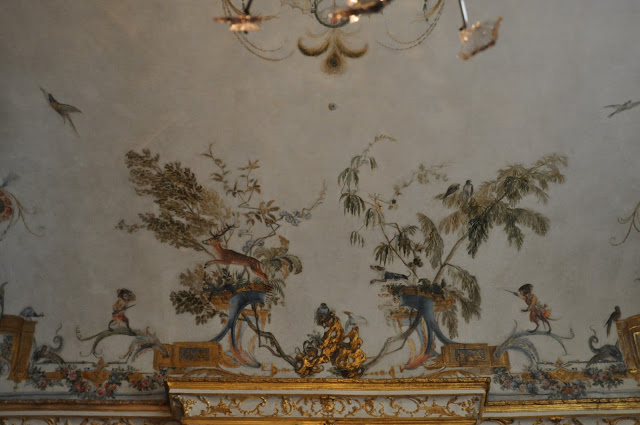These pictures may just be of the great, great grandfather of Chinoiserie styled wall decor in the Western world. Had I only know I would have made a greater effort in my picture taking. Unfortunately the whole tour we took through the apartments of Chateau de Chantilly was given late in the day only in very descriptive French and I missed a great deal. (like most of it.... that wasn't posted on the English card). On the very positive side of our tour there were only six in the group, so it was very special in such grand rooms. Now at home after researching just a little, regarding just one room - the Grande Singerie, I am doubly disappointed I was so incredibly ignorant regarding the history of this amazing Chateau. The building is a fabulous gem filled with a few life times of decorating and art to study.
So here goes the second installment of my Chinoiserie thoughts. As most of us know the French term Chinoiserie simply means a style of design that reflects Chinese influence, usually reflecting fanciful images of Chinese architecture (ie: pagodas) and or the chinese style of dress. It blended well with the popular rococo style of the mid 1700's making it a
trend of the era. European monarchs were intrigued and captivated by this new 'Chinese - esque' style, French, Russian, German and English monarchy and aristocrats all had craftsmen adapting the motifs on walls, railings, furnishings and dishware. It was a style that was very in vogue for well over one hundred years in various parts of Europe.
What I have found in my brief research regarding this one small fabulous room is - singes means monkey in French, so painting monkeys in elaborate human clothing and depicting them doing human tasks created a room then known as a Singerie. Nowhere have I found an explanation of how/why the singe and the chinose style were combined. Perhaps it was simply combining two trends that were very popular at the time. In the early 1700's many aristocrats and royalty were know to keep monkeys as pets and dress them in elaborate miniature costumes resembling their own, parading them about in palaces such as Versailles. I do believe it was time when exotica of all kinds from all continents was coveted by the rich. Maybe if I had been able to attend that lecture series recommended by Dianne Dorrans Sacks over at The Style Saloniste I'd have the answer!
The Grande Singerie dates from 1737 when the chateau was owned by the Prince de Conde. Antoine Watteau had originally been the artist attributed to having painted the Grande Singerie as early in his career he had painted what was considered the masterpiece of this genre with 30 paintings at the Chateau de la Muette. Sadly this Chateau was demolished long ago and all that remains of Watteau's work from there are engraved reproductions. The painting of the Singerie is now thought to have been done by the animal artist Christophe Huet. This would explain the singes incredible accuracy of depiction. This is one of the few Singeries still in situ. Unfortunately during the French revolution many of these decorated rooms were lost.
Recently restored by a team of 25 over a period of 6 months the Grande Singerie is spectacular. It is a dazzling little anti room or boudoir of just 320 square feet, it's ceilings, walls and doors completely painted in the most enchanting fashion and then embellished with filigreed frames and trims lavishly guilded. To top it all off there are 4 small chairs and a petite sofa from the bathroom of Marie Antoinette at Versailles designed by Georges Jacob, restored and upholstered in silk. Although I am still wondering why the sofa sits at 1/2 the height of chairs, thoughts? Many apologies for not having a picture of the whole Singerie.
If you ever have a chance, pass up Versailles for Chateau de Chantilly it is incredibly more exciting and I haven't even started in on the art collection!















3 comments:
wonderful post!
Thanks so much for reading... I had to cut it before I went into all the themes etc. that were in the room it is really amazing! If you ever have a chance go to Chateau Chantilly!
I am French so excuse me for my not fluent English. I would like to know if I could use your photographs to illustrate an article about Christophe Huet on the website www.meublepeint.com. If you agreed let me know what copyright I have to write below the photographs (©concrete jungle ?)
Best regards
Catherine
Post a Comment